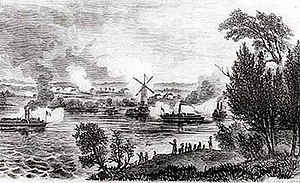Battle of the Windmill
| Battle of the Windmill | |||||||
|---|---|---|---|---|---|---|---|
| Part of the Patriot War, Rebellions of 1837 | |||||||
 Contemporary engraving of the Battle of the Windmill as seen from the American shore. |
|||||||
|
|||||||
| Belligerents | |||||||
| Hunters' Lodges |
|
||||||
| Commanders and leaders | |||||||
| Nils von Schoultz | Henry Dundas | ||||||
| Strength | |||||||
| 250 Hunter insurgents |
British: 1,133 Canadian militia 500 British regulars Royal Navy American: U.S. Army U.S. Navy |
||||||
| Casualties and losses | |||||||
| 53 dead 61 wounded 136 captured |
17 dead 60 wounded |
||||||
Anglo-American victory;
The Battle of the Windmill was a battle fought in November 1838 in the aftermath of the Upper Canada Rebellion. Loyalist forces of the Upper Canadian government and American troops, aided by the Royal Navy and U.S. Navy, defeated an invasion attempt by Hunter Patriot insurgents based in the United States with the intention of using it as a leap pad for offensives into Canada. Consequently, American and British troops thwarted them while defending Canadian soil and forced them back down south into the United States, where they were captured and arrested by U.S. officials.
After the first rebellion by disaffected Upper Canadians was suppressed in 1837, the majority of the rebel leaders fled to the United States. Popular sentiment in the States believed that the Canadians were eager to overthrow British rule and form a republic patterned after the American model, and an organization known as the Hunter Patriots was formed to assist the rebellion. Organized in neo-Masonic secret lodges, and with widespread support in the northern border states from Vermont to Wisconsin, the Patriot Hunters aimed to invade Canada and lead an army of insurgent Canadians against the British colonial government. In reality, much of the Canadian population was loyal to existing British institutions and decidedly against the prospects of revolution or invasion.
In November 1838, a group of Hunter Patriots decided that it was time to invade Canada and restart the rebellion. They chose as their target the town of Prescott, on the north bank of the St. Lawrence River downriver from Kingston. Prescott is the site of Fort Wellington, a British military fortification which commanded the St. Lawrence River and which was serving as a fortified depot for the Upper Canadian militia. To initiate the strike, a large group of Hunters assembled in Sackets Harbor, New York and descended the river to Ogdensburg in civilian vessels. Overall military command of the insurgent forces was held by John Birge, a senior member of the Hunter organization in New York state.
Early in the morning of November 12, a force of about 250 men attempted to land in Prescott. However, the British had infiltrated the Hunter organization, and had advance warning of the attack. With the element of surprise gone, and with the town militia ready to repel a landing, the Hunter forces were forced to abandon the landing. Both vessels ran aground on a mud flat where the Oswegatchie River flows into the St. Lawrence off Ogdensburg.
...
Wikipedia
